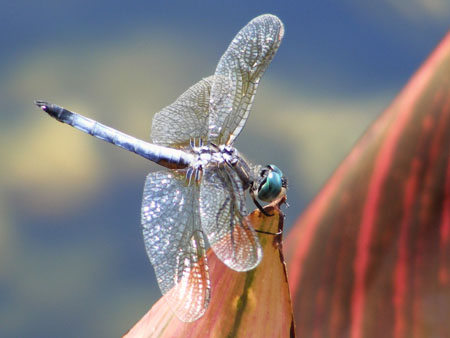The ideal time to photograph dragonflies is during the first two hours of daylight when the light is warm and fresh and the air is still damp. The insects are cool and torpid, and the muscles of their wings have not absorbed sufficient heat to enable them to fly. They consequently sit on vegetation with little desire to move or attempt flight, and are easier to approach than later in the day when their bodies have warmed. The best time of the year varies with location, so it is worthwhile taking local advice
Dragonflies can be photographed conveniently with a variety of lenses, although it is easier to keep some distance between the camera and the insect. This reduces disturbance, increases choice of background, and helps the photographer work in a more comfortable manner. Medium telephoto lenses in the range of about 105mm to 250 mm are all convenient provided the minimum focusing distance is sufficiently short. An extension tube can be added between the camera and the lens to achieve a shorter minimum focusing distance.
 |
| Dragonfly by kind permission of Joy Freschly, USA. |
Approach dragonflies in a stealthy manner and do not make any sudden or rapid movements. Also avoid casting shadows over the insects. The compound eyes of the insects are programmed to detect movement and colour, so wearing sombre colours is beneficial. It can also be worth covering the bright and highly-reflective parts of cameras and lenses to avoid moving highlights and flashes of light. If the insects fly away just remain patient and still. They usually return once things have settled down.
In many cases it is not necessary to use flash although a flashgun can be useful to add sparkle on a dull day, or to fill and soften shadows in harsh daylight. Dragonflies have beautiful lace-like transparent wings featuring intricate veins. These are more likely to sparkle in direct light, so adding a little fill-flash on a dull day does help in this respect. Another consideration in showing wings to their best advantage is the choice of background. If seen against a uniform blurred background the detailed wing structure is highlighted, but a busy background incorporating recognisable detail, colour changes and high contrast tends to conceal the beauty of the wings.
In general, choose a line of sight perpendicular to the plane of the dragonfly's body or wings so that the whole insect lies within the depth of field envelope. Working close to small insects is always a challenge in terms of depth of field, which may be measured in millimetres, so it is important to make best use of what is available. Ideally, a small aperture would always be used to maximize depth of field but this is not always practicable because the shutter speed must be high enough to freeze any movement.
The most readily accessible viewpoint is directly above the dragonfly. The insect can be photographed with wings spread and glistening in the morning light. Aligning the wings diagonally in the frame usually works better than positioning them directly across the frame. Another approach is to photograph the insect from the side but the depth of field requirements are consequently more challenging to satisfy. It is not essential to have the whole insect in sharp focus. However, when allowing parts of the wings or body to drop out of focus it is important to consider how the insect's extremities lead the eye to the centre of interest - usually the head or eyes of the dragonfly.
Photographing dragonflies in flight may seem almost impossible, but the insects have a convenient habit of returning to the same perch They sometimes also return to previously used hovering areas. It is therefore relatively easy to set up a camera on a tripod and focus on a favoured perch. When an insect approaches the perch, fire the camera in continuous high frame-rate mode to capture the approach and landing. A similar principle can be used to photograph dragonflies while they are hovering.






